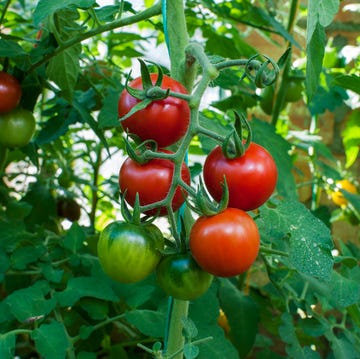Vintage cookbooks are so much more than just a compilation of recipes. They are really more like history books, but the kind that are actually fun to read—and even more fun to cook your way through! We are all nostalgic for Grandma’s cooking, and it’s likely she got some of her recipes from one of these cookbooks by top names such as Betty Crocker and James Beard. But, even if you don’t want to actually cook from them, vintage cookbooks are a great collectible to add nostalgic charm to a cottage- or farmhouse-style kitchen.
Some can be worth a pretty penny, too, so be sure to check your Grandma’s kitchen (or a local thrift shop or estate sale) for a hidden treasure. (A first edition of The Joy of Cooking can bring upwards of $10,000!) Note: In most instances, a first edition copy in excellent condition is going to have the most resale value.
Here’s a peek inside some of our food editors’ favorite vintage cookbooks:
The Fireside Cook Book
Written by legendary American chef James Beard, The Fireside Cook Book (1949) taught home cooks how to master both the fundamental (scrambled eggs) and the highfalutin (venison ragout). In addition to 1,000-plus recipes, the cookbook is a visual feast, thanks to 400 folksy illustrations by Alice and Martin Provensen, illustrators who worked on everything from Little Golden Books to Disney’s Pinocchio and Fantasia. They even drew Kellogg’s first Tony the Tiger.
About the Author
With one of the first regularly televised cooking shows on air, James Beard defined mid-20th-century American cooking. A literal giant in the food world (at 6'3", he stood an inch over Julia Child), his name adorns one of the most prestigious food awards today.
Country Crowd-Pleaser
James provides erstwhile hosts one-stop meal planning with dozens of drool-worthy “menus for warm and cold weather meals,” including a classic Thanksgiving-based “American Dinner” with roasted turkey, chestnut dressing, creamed onions, and cranberry and almond relish. Excuse us while we go make all of that.
Sign of the Times
James insisted cocktail snacks should be “well flavored and pungent.” His section on hors d’oeuvres is a gold mine of 1940s and ’50s tastes, including the Thirst Inviter, a dunking bowl (what we now refer to as a dip) made of garlic, sour cream, chile sauce, chopped hard-cooked eggs, and horseradish.
Game for Anything
Oregon-born James was certainly a gourmand—there are loving descriptions of roast pheasant and French croquettes in the book—but he was no eating elitist. Among the less rarified dishes are recipes for four different fried chickens, barbecued spare ribs, boiled pigs’ feet, and raisin pie.
What It’s Worth:
James Beard has serious chef cred, with a name known both in and out of the foodie circle. That being the case, copies of the earliest edition of The Fireside Cook Book can bring close to $400 (probably even more if you happen upon a signed copy!).
Betty Crocker’s Cooky Book
From everyone’s favorite (fictional) pearl-decked home cook, Betty Crocker’s Cooky Book is the essential treasury of baked sweets discerning ’60s grandmas kept tucked away, lest the little ones learn their favorite treats weren’t actually old family recipes. First printed in 1963, this spiral-bound compendium contains more than 450 recipes in sections like “Family Favorite” and “Holiday Cookies.” One section even details the most “fashionable” cookies from 1880 to 1963, along with historical notes. (It seems French Lace cookies were all the rage in the early 1960s.)
About the Author
A brand name since 1921, the Betty Crocker character was first created to help answer consumers’ questions. She quickly became a household name, and her name and portrait (which has evolved over time) have graced boxed foods, cookbooks, and more. By 1945 she was second only to Eleanor Roosevelt in name recognition.
Cookie vs. Cooky
Though Betty’s spelling of the word cookie may look a little, er, kooky, in 1963 it was actually a well-known (if fading) spelling. By the end of that decade, though, “cookie” was the common spelling and “cooky” was mostly used as a nickname for cooks.
Holiday Highlights
The sweet spot of this book, of course, is the Christmas cookies: red and green jelly cookies, snowballs, candy cane cookies, and more. There’s also great advice for making gift-worthy containers, hosting cookie swaps, planning holiday baking, and making cookie ornaments for your Christmas tree.
Signs of the Times
Quite a few of Betty’s recipes call for shortening, a solid vegetable oil that keeps dough flaky and tender. Health-conscious cooks started steering clear of the pantry staple in the ’70s, but most modern versions are trans-fat-free. (Tip: Butter works as a one-to-one substitute.)
What It’s Worth:
Betty Crocker is a big name with wide appeal, so books under the Betty Crocker name are always popular. Prices vary for Cooky Book, with excellent condition versions of the earliest edition bringing up to $120. Also be on the lookout for the Betty Crocker Picture Cook Book (with the red cover) which can also be worth up to $100.
Mennonite Community Cookbook
If you’ve ever purchased a pie at a Mennonite church bake sale, chances are you’ve gotten a taste of the Mennonite Community Cookbook. Find out why its 400-plus pages offer a hearty feast for both barn-raisers and home bakers. First published in 1950, this collection of 1,100 recipes compiled from Mennonite women across North America aimed to preserve food traditions that go back centuries and often reflect German and Dutch heritages. Still in print, it remains popular among both Mennonites (an Anabaptist Christian community) and the Menno-curious.
About the Author
Home economics professor Mary Emma Showalter Eby single-handedly tested nearly 600 cake recipes for her thesis-project cookbook. At the insistence of her committee chair, she even beat all of that batter by hand.
Country Crowd-Pleaser
No Mennonite barn raising is complete without strong-man sustenance. The robust “Food for a Barn Raising” menu insists that 115 lemon pies; 500 fat cakes (aka doughnuts); 3 gallons each of apple sauce, rice pudding, and cornstarch pudding; 16 chickens; 3 hams; 50 pounds of roast beef; and more would feed 175 men.
A Can-Do Spirit
From Busy Sister cold pickles and Granddaddy’s Green Tomato Pickle to even Spiced Cantaloupe, the preserved fruits and veggies section is a gold mine of canned garden goods. No wonder those vinegar crocks were so large!
Most Retro Recipes
Molded salads! Mary Emma’s book features more than a dozen of these ringed delights— boasting happy names like Golden Glow—that start with a packet of gelatin and end with all sorts of combinations of fruits and vegetables.
What It’s Worth:
Hard copy versions of Mennonite Community Cookbook can be worth up to $50.
Community Cookbooks
Typically spiral-bound, these time-honored recipe compilations feature “best of” bites from ladies’ clubs, church congregations, garden clubs, and more. You can’t go wrong with classics like Charleston Receipts (the oldest Junior League cookbook still in print; original 1950 printings are hard to come by!), but don’t discount lesser-known bargain-bin gems, sometimes coveted solely for their retro titles or sweetly humble cover designs.
What It’s Worth:
This category is all about the popularity of the title. For example, a 1950s edition of the widely sought after Charleston Receipts can bring upwards of $80 to $100, while many of the less known cookbooks can be snagged for under $10. In this category, it’s the thrill of the hunt of finding a book from your home town, or even your childhood church.
County Fare: American Cookery with a Country Flavor
For hearty, farm-style recipes (think nose-to-tail) and country life lore (shelling peas on the side porch), snag a copy of County Fare: American Cookery with a Country Flavor. These 400-plus recipes—wrought from the days when dinner plates, by necessity, reflected the seasons—“stand for American cookery at its best,” writes author Mary Elizabeth Bauhan in her 1959 cookbook.
About the Author
Raised on her family’s 200-acre Upstate New York farm, Mary Elizabeth writes vividly about her early years spent thinning onions, canning fruit, and learning to cook at her mother’s knee. Her daughter, Joyce, provides all the cookbook’s illustrations.
The Proof Is in the...
In true country fashion, nearly 100 of the cookbook’s 232 pages are given over to desserts, including Snow Pudding—a frothy mass of sweetened egg whites surrounded by a thick vanilla custard sauce.
Scrutiny on the Bounty
Mary Elizabeth offers reflections on a variety of veggies, from broccoli to eggplant, but waxes most poetic about sweet corn: “We had it from as early as possible until frost killed it. The last few messes were literally snatched from the clutches of a relentless freeze.”
A Can-Do Attitude
Preserving produce is more than mere convenience when you’re growing the bulk of your provisions. Mary Elizabeth shares tips gleaned from several generations of Bauhans, including recipes for watermelon rinds, pickled peaches, and a nine-day cucumber pickle she calls “the oldest of all pickling recipes in our family.”
The Art of Fish Cookery
A summer kitchen must-have, The Art of Fish Cookery (1949) has ideas for whatever you happen to reel in.
Source Material
Recipes are divvied into freshwater, saltwater, and shellfish categories.
Name that Species
From stalwarts like flounder and trout to treasures such as lake herring and oyster crabs, you’ll be able to ID—and properly cook—practically anything that comes out of water.
Caught or Bought
Smart guides help you spot the freshest fish at the market and then clean and dress ’em like a pro.
What It’s Worth:
Early editions of The Art of Fish Cookery can be worth anywhere from $20 to $50, depending on condition.
Christmas Booklets
Most of these volumes date from the 1940s to the ’70s and ’80s. In addition to the traditional spiral cookbook format, classic cookie recipes were often published as promotional booklets and distributed by power companies (like the Wisconsin Electric Power Company’s annual Christmas Cookies collection, center left) in the 1950s.
What It’s Worth:
Most Christmas books and pamphlets can be found for less than $25.
Start Collecting:
For similar tasty treasuries, feast your eyes on the offerings at omnivorebooks.com, blackbirdcookbooks.com, bonnieslotnickcookbooks.com, as well as etsy.com and ebay.com for specific titles. Library book stores are also great places to look!

Christopher Michel has been the Senior Food and Gardens Editor at Country Living Magazine since March of 2021. Chris has over ten years of experience writing and editing for national magazines and websites, mostly in the food space, such as Cooking Light, The Kitchn, Rodale’s Organic Life, and Bon Appetit. Prior to that, Chris worked in a variety of food spaces in New York City. In 2022, Chris completed the Alabama Master Gardener’s Program hosted by the Alabama Cooperative Extension System.
Chris lives in Birmingham, AL, where he enjoys running, reading, and cooking for his wife and two girls.

Natalie Schumann is a former Associate Editor at Country Living, where she managed CL's social channels and covered country music and entertainment news.
























